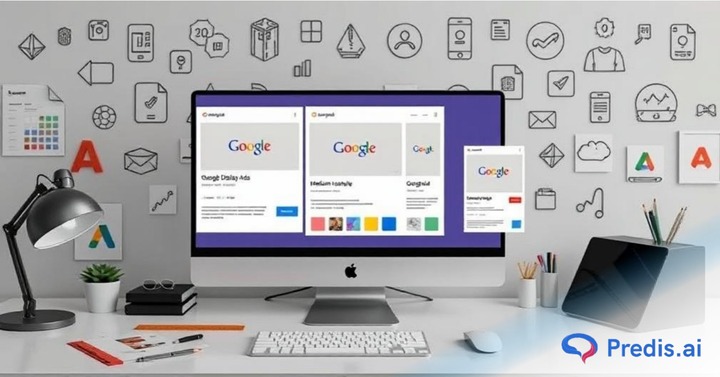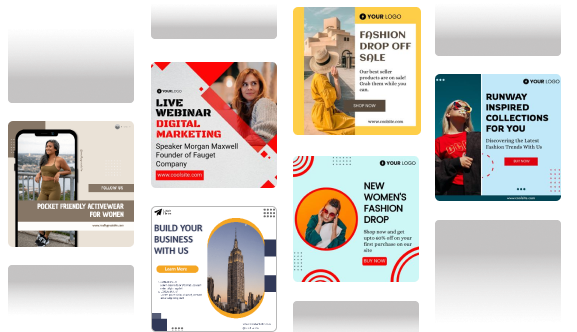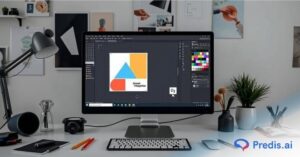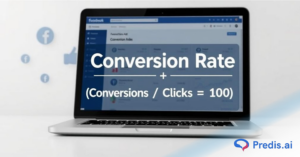Confused about which Google Display Ad sizes will deliver the best results? Your choice of Google ad size is critical to your campaign’s success. In this blog, we’ll clarify which ad sizes and formats are most effective for various marketing goals.
Whether you aim to increase brand visibility, re-engage previous visitors, or drive more traffic to your site, selecting the right Google ad size is essential.
We’ll break down the top Google display ad sizes and explain how to use them to enhance your ad performance and meet your objectives more effectively. Get ready to make informed decisions and boost your campaign results. To start, it’s important to understand what Google Display Ads are.
What Are Google Display Ads?
Google Display Ads are a crucial element of digital marketing. They allow businesses to reach users across more than two million websites, apps, and Google platforms like YouTube. These ads use images, text, and multimedia to grab attention and boost engagement.
Unlike search ads, which target users based on their search queries, display ads focus on demographics, interests, and browsing behavior. This makes them effective for:
- Building Brand Awareness: Introduce your brand to a broad audience.
- Retargeting: Re-engage users who have previously interacted with your business.
- Reaching Users at Different Buying Stages: Connect with potential customers throughout their buying journey.
Think of Google Display Ads as digital billboards on the internet. Just as physical billboards catch the eye of drivers, well-sized display ads aim to capture the attention of online users. Given that Google’s Display Network reaches over 90% of global internet users, having your ad properly sized and positioned is essential for maximizing its effectiveness and impact.
Here’s a Google display ad example:

There are 2 types of Google Display ads, which are Image Ads and Responsive ads.
Image ads are static and if you want it to fit multiple placements then you have to create various versions of it. Using static ads means you get complete control over your design and story-telling.
On the other hand, Responsive ads are flexible in nature, thus adapting to all types of screens: desktops, mobiles, and tablets. All this without taking a hit on efficiency.
Choosing a type of ad from these two options totally depends on your strategy and how you want to engage with your audience.

Google Display Ads Sizes Explained: How to Choose the Best Dimensions for Your Ads
Choosing the right Google Display Ad sizes can significantly influence your campaign’s success. Each size brings specific benefits that contribute to greater visibility and user engagement. But, no one ad size fits everyone. Therefore, take a pick of your ad size and A/B test it until you get one that works to your benefit.
Here’s a detailed look at each ad size and tips on how to use them effectively to help you get started.
Ad Specifications for Google Display Network
When uploading ads to the Google Display Network, it’s crucial to adhere to specific size and format requirements. Depending on the ad type, you will need to use certain image sizes and formats. Here’s a breakdown of the file formats and size limits you should be aware of:
To ensure your ads meet Google’s standards, follow their latest guidelines for dimensions, file size, and animation length. JPEGs are usually preferred for their efficient compression, keeping file sizes within the 150KB limit more effectively than PNGs.
File Formats and Size Requirements:
- Supported Formats: GIF, JPG, PNG
- Maximum File Size: 150KB
- Resolution: High-resolution images such as 1600 x 1200, 1600 x 900, 1280 x 1024, 1152 x 864 is good.
If your file size exceeds the said file size limit, then you will have to compress it before you can use it. To compress, you can either use Adobe Photoshop or Illustrator or you can use tools available online.
Below, you’ll find the specifications for Google Display Network ad sizes as detailed by Google Ads. We’ve also included a comprehensive list of Google Ads display sizes to help you make informed decisions for your advertising strategy.
Ad sizes
Square and rectangle
| 200 × 200 | Small square |
| 240 × 400 | Vertical rectangle |
| 250 × 250 | Square |
| 250 × 360 | Triple widescreen |
| 300 × 250 | Inline rectangle |
| 336 × 280 | Large rectangle |
| 580 × 400 | Netboard |
Skyscraper
| 120 × 600 | Skyscraper |
| 160 × 600 | Wide skyscraper |
| 300 × 600 | Half-page ad |
| 300 × 1050 | Portrait |
Leaderboard
| 468 × 60 | Banner |
| 728 × 90 | Leaderboard |
| 930 × 180 | Top banner |
| 970 × 90 | Large leaderboard |
| 970 × 250 | Billboard |
| 980 × 120 | Panorama |
Mobile
| 300 × 50 | Mobile banner |
| 320 × 50 | Mobile banner |
| 320 × 100 | Large mobile banner |
Square and rectangle
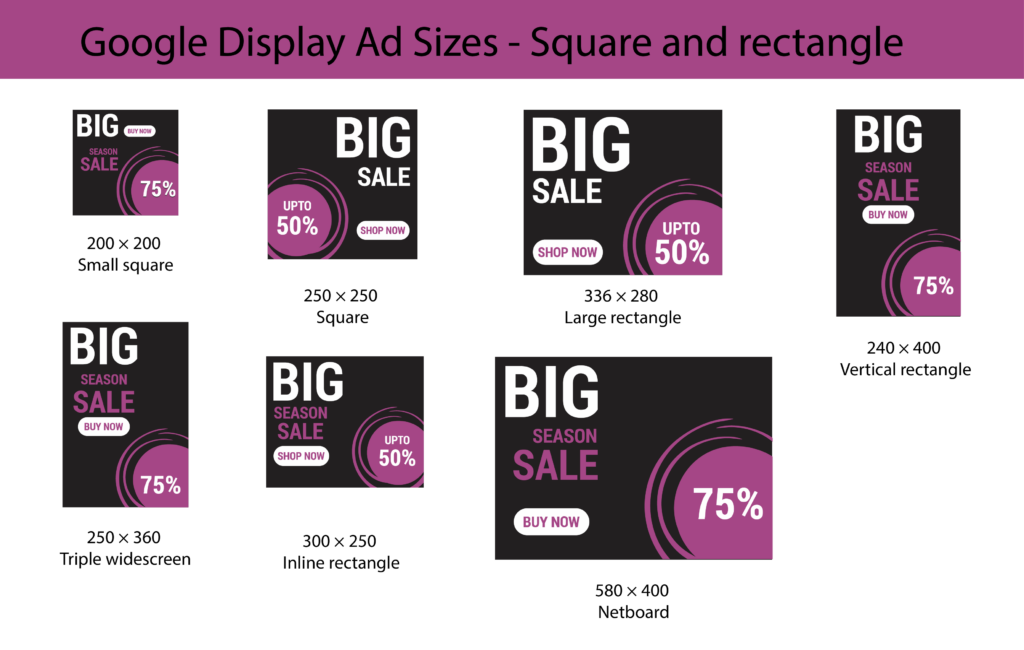
1. Small Square (200×200)
When dealing with limited space, the 200×200 small square ad is a valuable asset. It’s perfect for placements in sidebars, footers, or any small area where larger ads might not fit. Despite its compact size, it remains visible and can be highly effective for concise messaging.
This ad size works well for local promotions or supplementary ads that need to catch the eye without overwhelming the page. It’s ideal for situations where you want to deliver a quick reminder or a brief promotion. Even though it’s small, placing it strategically in high-traffic areas ensures it still makes an impact.
Small ads like this one can be surprisingly effective when used in the right context. They’re a great way to complement larger ads, offering a balanced approach to your advertising strategy.
2. Vertical Rectangle (240×400)
The 240×400 vertical rectangle ad stands out due to its tall, narrow shape. This size is excellent for content-rich websites where users scroll through long articles or pages. Its vertical design keeps the ad in view longer, which can lead to better engagement.
This Google ads display size is perfect for areas where you need to maximize visibility without taking up too much horizontal space. It fits well in sidebars or along the edges of content, making sure your brand remains in sight as users scroll down the page.
Tip: Use this ad size to maintain a prominent presence on long-form content pages, ensuring that your message remains visible as users engage with the site.
3. Square (250×250)
The 250×250 square ad is a versatile option that works well across various placements. Its equal width and height make it adaptable, whether placed within content or on the sidebar. This size is effective on both desktop and mobile devices, making it a reliable choice for many types of campaigns.
This size is great when you want an ad that fits seamlessly into various layouts. Consider using it for general-purpose ads that need to work across different devices and placements.
4. Triple Widescreen (250×360)
The 250×360 triple widescreen ad provides an expanded format compared to traditional rectangles, offering additional space for creative visuals and messaging. Its wide and tall design is ideal for high-impact campaigns where more room is needed to capture user attention.
This ad size works well in high-visibility areas, allowing for a combination of strong visuals and compelling content. It’s perfect for campaigns that require a substantial presence on the page, similar to a large, striking billboard that commands attention.
Tip: Opt for the 250×360 size when your campaign requires a larger canvas for images or a more detailed message. It’s perfect for creating visually rich ads that stand out.
5. Inline Rectangle (300×250)
The 300×250 inline rectangle is one of the most popular ad sizes due to its versatility. It fits well in a variety of placements, including within content or in sidebars. This size consistently performs well across both desktop and mobile devices.
High demand for this ad size underscores its effectiveness, as it is often referred to as a “workhorse” in digital advertising due to its strong performance metrics. It commands high click-through rates (CTRs) and is frequently requested by advertisers, reflecting its ability to engage users effectively.
Tip: Use the 300×250 ad size when you need a reliable option that works well in various contexts. It’s a solid choice for ensuring your message is seen without dominating the user experience.
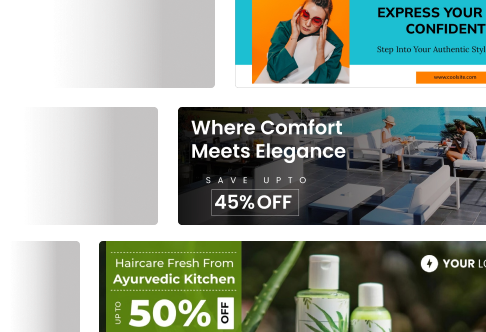
6. Large Rectangle (336×280)
If you’re looking to make a bold statement, the 336×280 large rectangle ad provides the extra space needed for impactful design and messaging. This format is ideal for content-heavy sites where a larger ad can stand out and capture user attention more effectively. It’s like having a spacious billboard in a prime location—providing ample room to shine.
This size is great for incorporating detailed visuals or extensive text, making it a valuable option for campaigns that require more room to make an impact. The additional space allows for a more comprehensive presentation, which can significantly enhance user engagement.
Tip: Choose the 336×280 size when you want to make a significant impact on your audience. It’s ideal for delivering detailed content or high-quality images in a prominent spot.
7. Netboard (580×400)
When aiming for maximum impact, the 580×400 netboard is your best choice. This large-format ad offers a wide canvas for detailed and attention-grabbing content, akin to having an entire wall to showcase your message. It’s perfect for high-visibility placements.
This size is ideal for prominent locations where immediate attention is crucial. Its generous dimensions are well-suited for detailed promotions, high-impact visuals, or comprehensive messages that need extra space.
Tip: Opt for the 580×400 size for important campaigns that require immediate attention. Its expansive format is perfect for delivering impactful and detailed advertisements.
Skyscraper
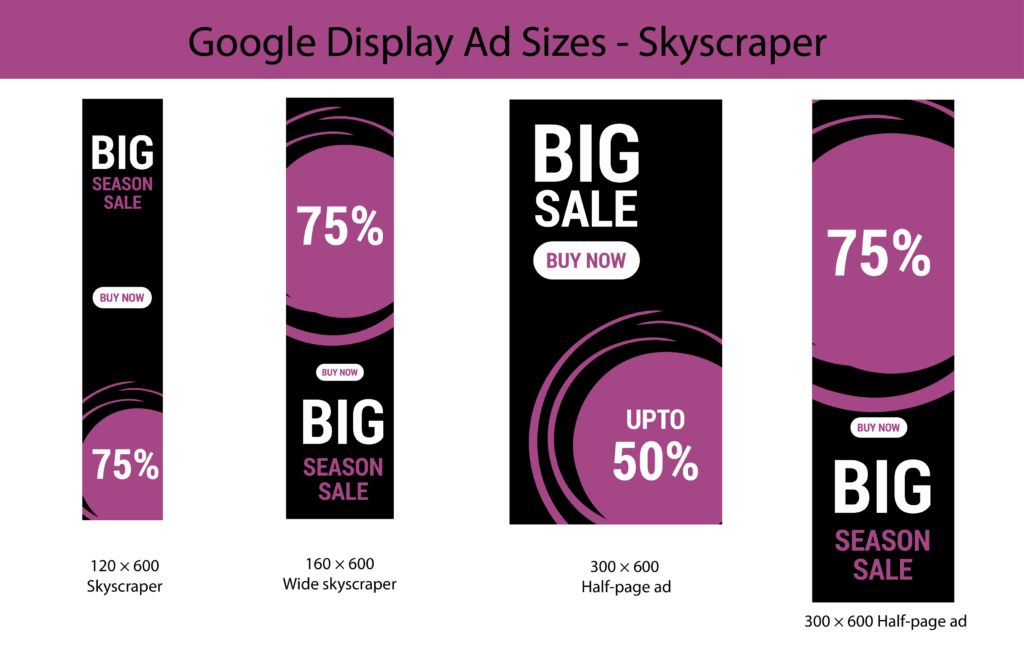
1. Skyscraper (120 × 600)
The 120×600 skyscraper ad is one of the more compact vertical options, making it perfect for sidebars. Its tall and narrow design means it’s visible as users scroll, ensuring your ad remains in view without taking up too much space. This ad size is great for campaigns that require consistent exposure without being too intrusive.
If you’re looking to maintain a subtle yet consistent brand presence on content-heavy websites, the 120×600 skyscraper ad is a solid choice. Its narrow format allows it to blend seamlessly into sidebars while still catching the eye.
This makes it particularly effective on websites where readers spend a lot of time on individual pages, giving your ad repeated exposure.
2. Wide Skyscraper (160 × 600)
The 160×600 wide skyscraper is a popular ad choice due to its larger width, offering more space to convey your message. This ad size strikes a balance between visibility and subtlety, making it an effective tool for boosting brand awareness.
The added width of the wide skyscraper allows for greater creative flexibility, enabling you to include compelling visuals or additional text to enhance your message. It’s particularly effective on content-heavy pages, where it remains noticeable as users scroll.
Consider using the 160×600 wide skyscraper for campaigns that require a strong yet non-intrusive presence. Its size is perfect for making a lasting impression without overwhelming the viewer.
3. Half-Page Ad (300×600)
If you’re looking to make a big impression, the 300×600 half-page ad is your best bet. This size is essentially two standard ads stacked on top of each other, providing ample space to tell your story, showcase a product, or present an offer.
Due to its size, this ad format is particularly effective on content-heavy sites where you want to ensure your message is seen. The half-page ad is often placed within the main content area, giving it high visibility and engagement potential.
It’s a great choice for campaigns where you need more room to grab attention and drive conversions.
4. Portrait (300×1050)
The 300×1050 portrait ad is one of the largest vertical ad formats available, offering a significant amount of space to get your message across. This ad size is perfect for high-impact campaigns where you want to dominate the page.
Placed prominently, it’s almost impossible to ignore, making it ideal for brand awareness campaigns or detailed product showcases. The portrait format works best on visually focused websites where the extra space can be utilized to create a strong visual impact.
If you need an ad that stands out and stays with the user, the 300×1050 is the format to consider.
Leaderboard
1. Standard Banner (468 × 60 pixels)
The standard banner is a classic format that has been around since the early days of digital advertising. Although less common today, it remains useful in specific contexts. Standard banners are compact, making them suitable for areas with limited space.
They have an average click-through rate (CTR) of approximately 0.1%, which, while lower than more prominent formats, can still be effective for brand recall and retargeting campaigns. These banners are often used to remind users of products they’ve previously shown interest in, reinforcing brand presence.
To optimize the impact of standard banners, ensure they are well-designed with clear calls-to-action (CTAs) and visually engaging elements.
2. Leaderboard (728 × 90 pixels)
The 728 × 90 leaderboard is among the most popular Google ads display sizes in display advertising, known for its prime placement at the top of web pages. This ad size is highly favored for its ability to capture user attention right from the start.
According to Google Ad Manager, the 728 × 90 leaderboard accounts for a significant portion of display ad impressions, reflecting its widespread use and effectiveness.
Additionally, Bannersnack reports that this size achieves an average click-through rate (CTR) of 0.23%, which is notably higher than many smaller banner sizes.
3. Top Banner (930 × 180 pixels)
The top banner offers a balanced approach with its increased height compared to the leaderboard. Measuring 930 × 180 pixels, it provides ample space for creative content without overwhelming users.
Studies have shown that top banners can boost brand recall by up to 21%. They are especially effective on news and media websites, where they blend well with content while maintaining high visibility. The extra vertical space allows for more elaborate designs and engaging visuals.
Pro Tip: Take advantage of the additional height to incorporate dynamic elements like animations or interactive features that can enhance user engagement.
4. Large Leaderboard (970 × 90 pixels)
The large leaderboard, at 970 × 90 pixels, extends the width of the standard leaderboard, allowing for more comprehensive messaging. This expanded format can increase engagement rates by up to 30% compared to standard leaderboards.
It is particularly effective for industries like e-commerce and travel, where displaying multiple products or destinations in one ad can be highly effective. The wide format provides a panoramic view, enhancing the visual appeal and storytelling potential of the ad.
Pro Tip: Use large leaderboards to create immersive advertising experiences. Feature multiple products or create a visual story that captures user interest.
The increased width of large leaderboards offers more creative flexibility. Ensure your design utilizes this space effectively to highlight key offers or messages.
5. Billboard (970×250)
The 970×250 billboard ad is one of the largest standard formats available, making it perfect for high-impact, high-visibility campaigns. This large format is ideal for creating rich media ads that can include interactive elements like mini-games or product demonstrations.
The billboard’s expansive canvas allows for high-impact campaigns that aim to significantly boost brand awareness and engagement.
6. Panorama (980 × 120 pixels)
The panorama ad, at 980 × 120 pixels, provides a wider format than the large leaderboard, offering a cinematic feel across web pages. This format is especially effective for visually-driven industries like entertainment, creating immersive advertising experiences with engaging visuals and narratives.
Use panorama ads to showcase stunning content or tell a compelling story. Its wide format is perfect for creating engaging, immersive experiences that captivate viewers.
Ideal for industries reliant on visual appeal, panorama ads help your content stand out and engage audiences with rich, dynamic visuals.
Mobile
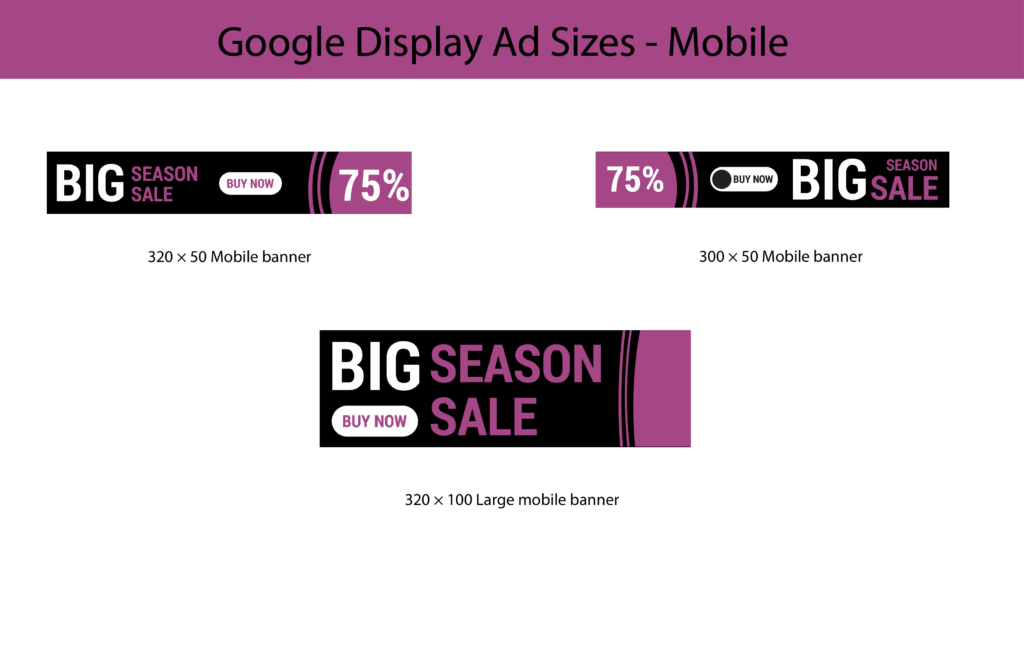
1. Mobile Banner (300 × 50)
The 300×50 mobile banner may be small, but it’s mighty. It’s ideally sized to fit unobtrusively at the top or bottom of mobile screens, ensuring your message is visible without disrupting the user’s browsing experience. This compact format is perfect for straightforward, direct messages that blend seamlessly with mobile content.
2. Mobile Banner (320 × 50)
The 320 × 50 mobile banner expands on the 300 × 50’s compact format by offering a bit more space. This additional width allows for more engaging visuals and messaging while maintaining an unobtrusive presence at the top or bottom of mobile screens.
With more room for visual appeal and detailed messaging, this size is a valuable asset for mobile advertising, providing a balance between visibility and user experience.
3. Large Mobile Banner (320 × 100)
The 320 × 100 large mobile banner offers significantly more space, allowing for richer content and more engaging visuals. This size is ideal for delivering detailed messages, promotional offers, or interactive content on mobile devices.
This expanded format enhances visibility and engagement, making it a key player in mobile advertising strategies. It’s particularly effective for campaigns that require more room to showcase complex or visually appealing content.
Why Are Google Display Ads Sizes Important?
When it comes to Google Display Ads, size does matter. Imagine scrolling through a website and spotting an ad that perfectly fits your screen—it’s eye-catching and easy to engage with. That’s the impact of choosing the right display ad sizes.
1. Reach Beyond Search
Google Display Ads are your ticket to reaching people across millions of websites, apps, and YouTube. But if your ad isn’t the right size, it might not display correctly or catch users’ attention.
2. Match Your Goals
Different ad sizes work better for different goals. If you’re aiming to drive website traffic, a larger desktop ad might be ideal. For on-the-go users, a smaller mobile-friendly ad could be more effective. Choosing the right size helps you meet your campaign objectives.
3. Budget-Friendly Advertising
Google Display Ads offers flexible budgeting, but ad size can affect your ROI. An ad that’s too big or too small might not perform well. By selecting the right sizes and keeping an eye on performance, you can make sure your ad spend is used wisely.
4. Drive Repeat Purchases
Google Display Ads are essential for influencing buying behavior. With 90% of consumers saying ads affect their decisions, using display ads to show related or new products can entice users to return and make additional purchases. This strategy helps maintain interest and encourage more frequent shopping.
5. Easy Campaign Management
Google’s AI tools make managing display ads a breeze. They help with targeting, bidding, and format adjustments, ensuring your ad sizes are optimized across different platforms.
6. Drive More Traffic to Your Website
With Google Display Ads averaging a CPC of $0.63, you can boost your website traffic with minimal risk. This cost-effectiveness means you can explore various ad strategies and make changes as needed. It’s a practical way to attract more visitors and find the best tactics to increase engagement with your site.
7. Effective Targeting and Smart Bidding
With precise targeting and smart bidding, you can reach the right audience with the right-sized ads. This approach helps you get the most out of your budget and increase your chances of conversions.
8. Quick Setup and Insights
Setting up your display ads is quick and easy, and you’ll get real-time analytics to track performance. This data helps you see what’s working and adjust your ad sizes and strategies for better results.
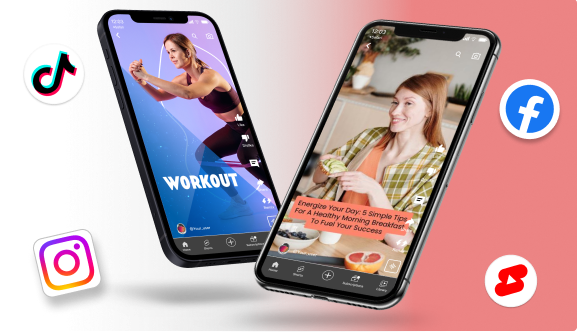
Google Display Ads Targeting Options: Audience vs. Content
Selecting the right targeting strategy for Google Display Ads is crucial for reaching your ideal audience. You have two main options: targeting by audience and targeting by content. Each method offers unique benefits and can significantly impact your ad performance.
Understanding how these targeting strategies work will help you connect with potential customers more effectively. Let’s break down each approach to see how they can enhance your advertising campaigns.
Targeting by Audience
1. Demographic Targeting
Demographic targeting lets you reach users based on attributes such as age, gender, location, and lifestyle factors like parental status or home ownership. For example, if you offer products for young professionals, you can focus your ads on this group.
This precision helps ensure your ads are seen by people whose characteristics match your target customer profile.
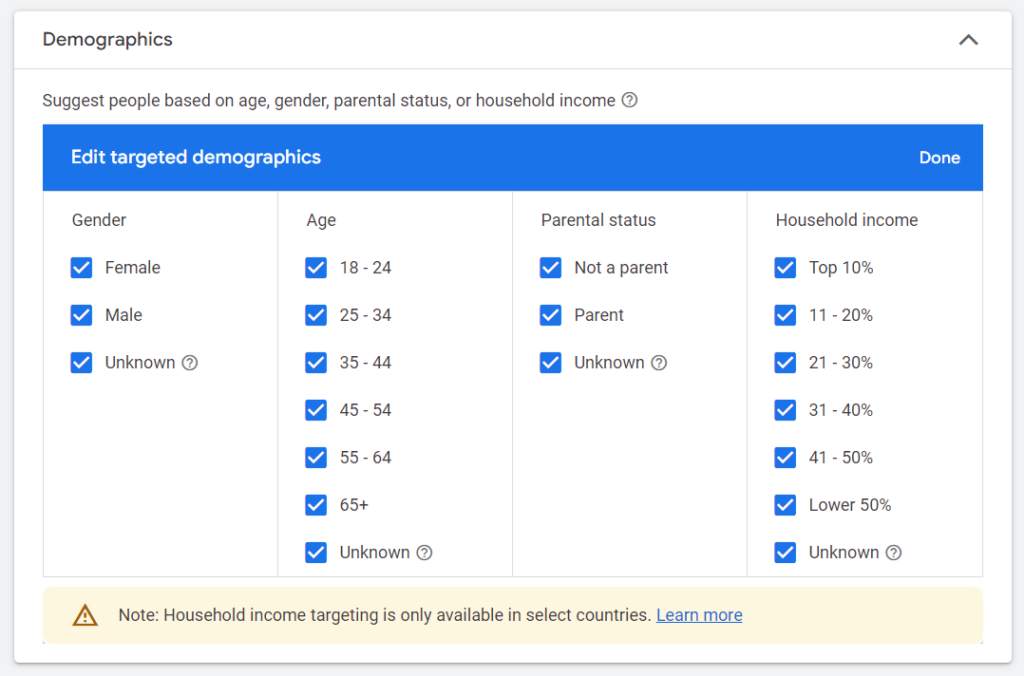
2. Affinity Targeting
Affinity targeting aims at users with a strong interest in specific topics or activities. For instance, if your business sells eco-friendly products, you can target individuals who are passionate about sustainability.
This strategy connects your ads with users who have ongoing interests related to your offerings, boosting the chance of meaningful engagement.
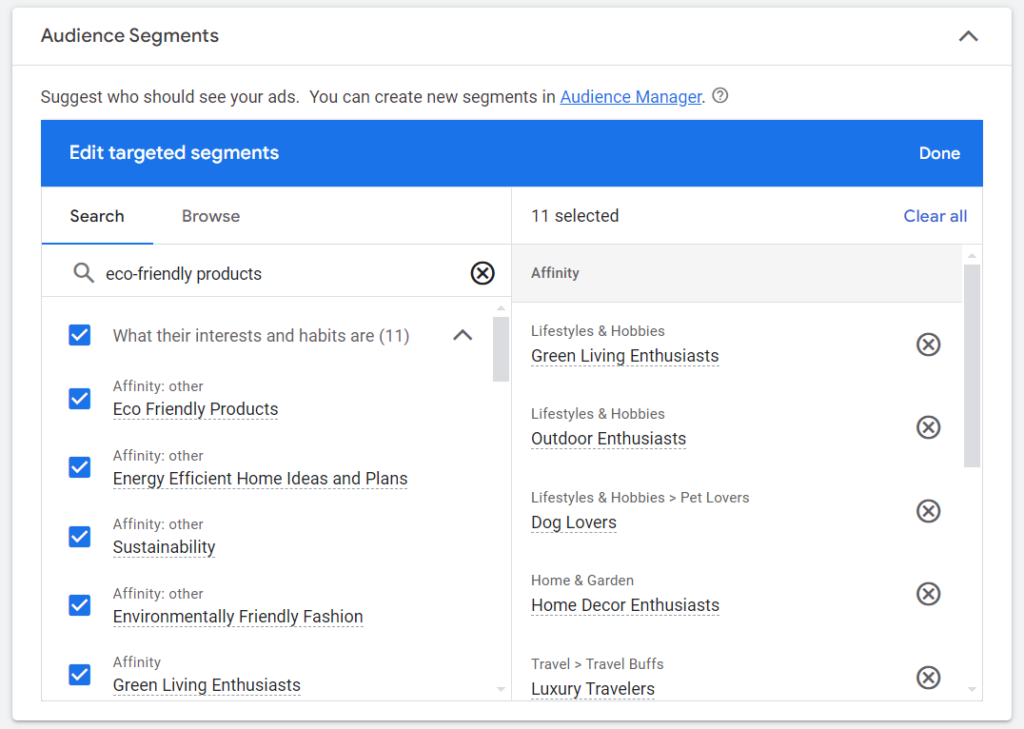
3. In-Market Targeting
In-market targeting focuses on users actively searching for or considering products similar to yours. If you operate a car dealership, you can target those currently looking for new vehicles or automotive services.
Targeting users who are already in the buying process increases the likelihood of conversion, as they are more likely to make a purchase soon.
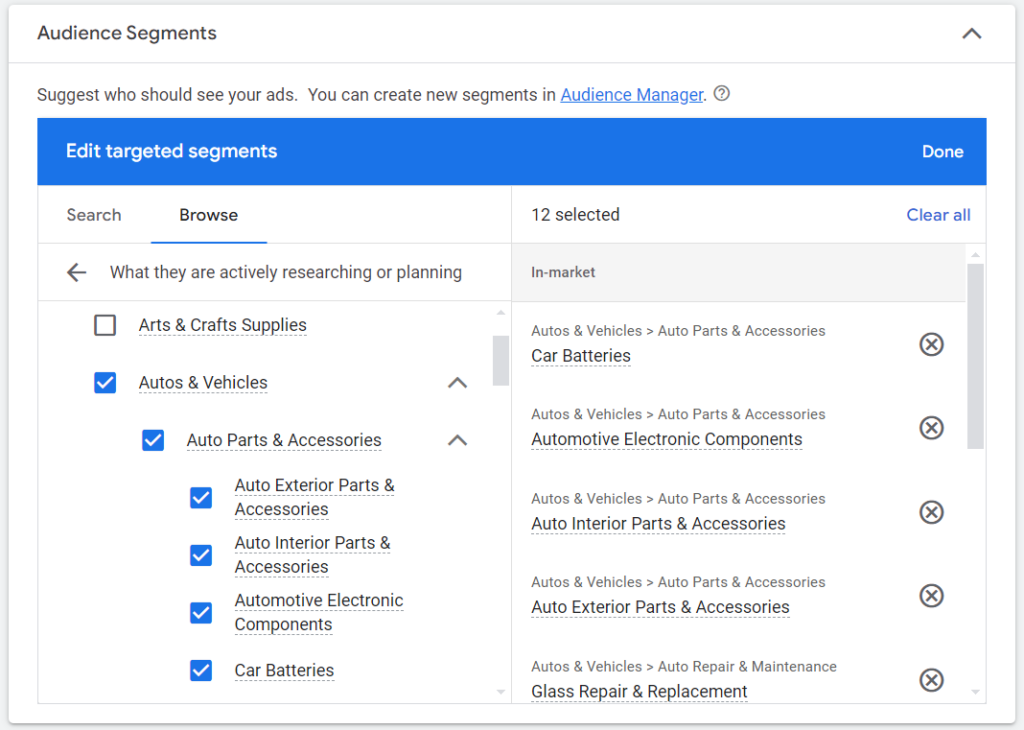
4. Remarketing
Remarketing targets users who have previously visited your website or app but haven’t yet converted. By showing ads to these users, you remind them of your products and encourage a return visit.
This keeps your brand visible to potential customers who have shown interest but need an extra nudge to complete a purchase.
5. Custom Audiences
Custom audiences allow you to create specific groups based on user behaviors, such as recent searches or website visits. For example, you might target users who have searched for travel destinations on related sites.
This high level of specificity ensures your ads reach users whose actions closely align with your business interests.
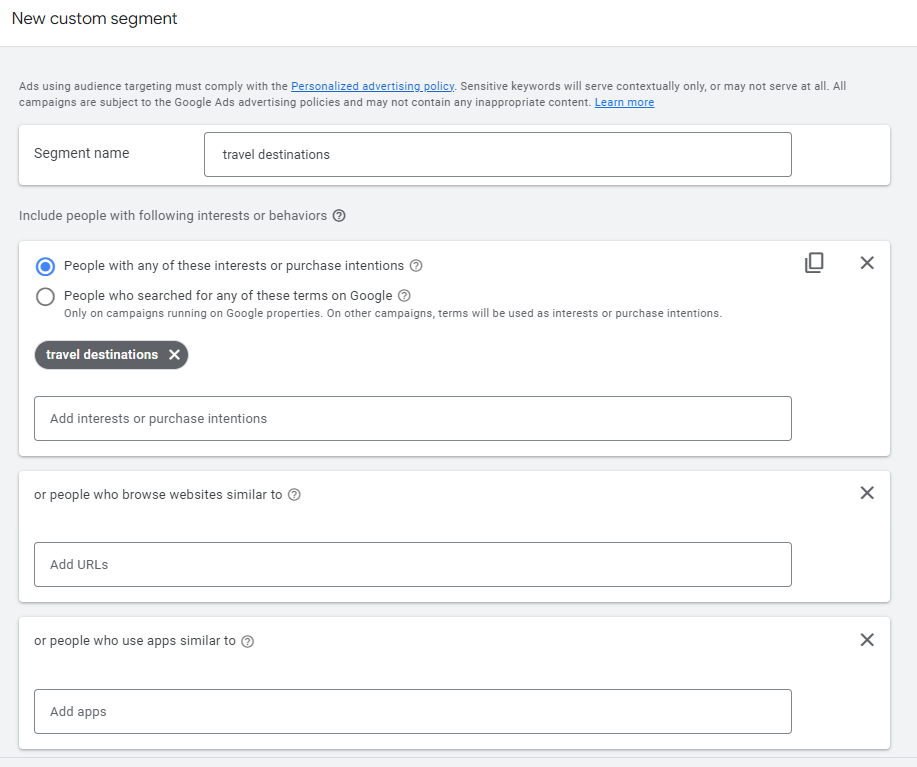
Targeting by Content
1. Contextual Targeting
Contextual targeting places your ads on web pages with content that matches the themes or topics relevant to your business. If you’re promoting outdoor gear, your ads might appear on sites discussing hiking or camping.
This method ensures your ads are shown in relevant contexts, increasing the chances they will resonate with users interested in similar topics.
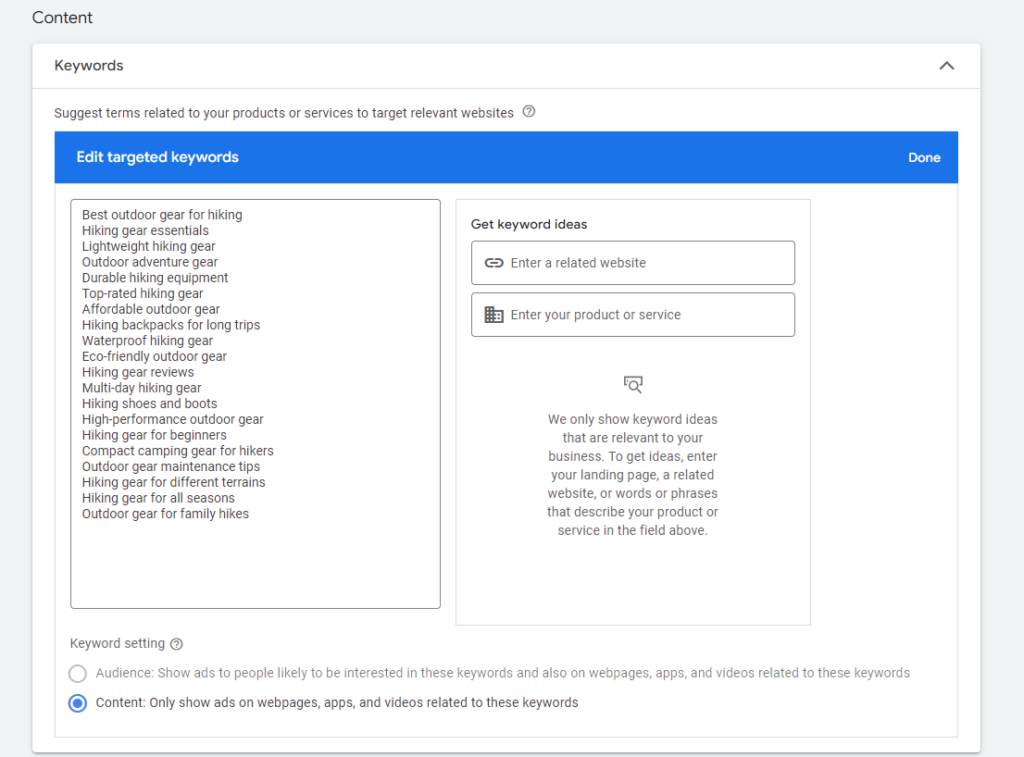
2. Topic-Based Targeting
Topic-based targeting shows your ads on pages about specific subjects. For instance, if you offer financial planning services, you can target pages discussing personal finance or investment.
This aligns your ads with content categories that match your business, enhancing their relevance and appeal.
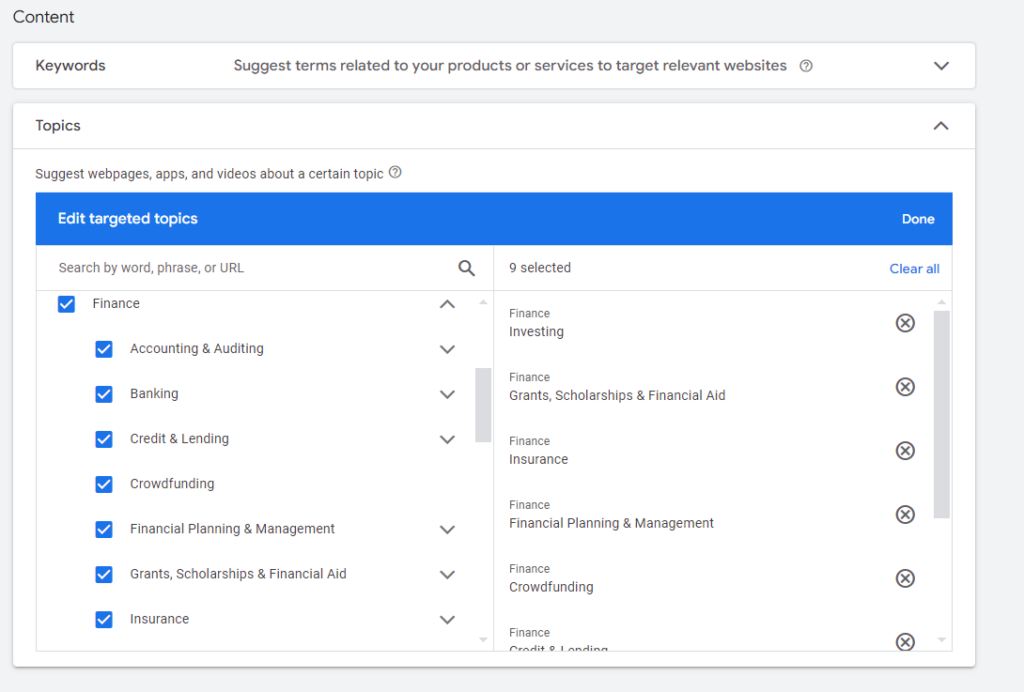
3. Placement Targeting
Placement targeting allows you to choose the exact websites, apps, or channels where your ads will appear. If you know your audience frequents particular sites, you can ensure your ads are displayed there.
This focuses your ad placement on high-traffic sites, increasing the visibility and impact of your ads.
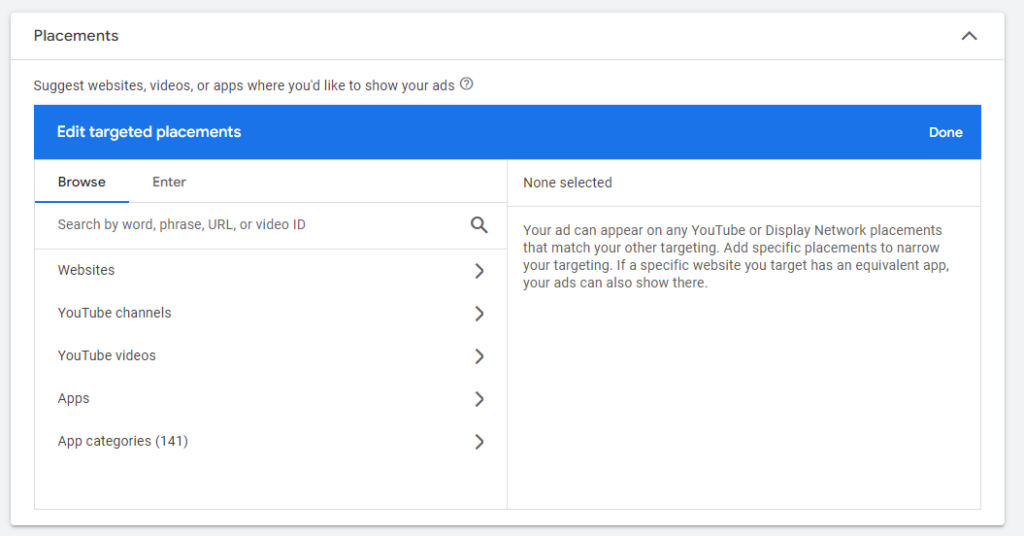
By effectively using these targeting options, you can ensure your Google Display Ads are seen by the right audience and in the most relevant contexts, enhancing your campaign’s success.
Tips to Make the Most of Google Display Ads
- Use high-quality content: When it comes to ads, you have just a couple of minutes to grab the attention of your audience and intrigue them enough to click and convert. Using low-quality images can be a hindrance to this objective. With Predis AI’s Google Display Ads Generator, you can create ads that are in alignment with your brand identity in a matter of minutes. Or you can create your own ads with our very own pre-made templates! Our collaborative option allows you to bring in your team to maximize efficiency.
- A/B Test: To ensure the continued success of your ad, you need to constantly measure and improve their performance. You can also create multiple versions of a similar ad to figure out which performs best and then go from there.
- Use Space Efficiently: There are lots of components that make up a successful ad such as text, images, CTA, and so on. But display ads have minimum space which means you have to leverage these elements efficiently to improve your chances of success.
Conclusion
To wrap up, Google Display Ads can significantly boost your marketing efforts by tapping into the extensive Google Display Network. Choosing the right ad sizes and targeting options is crucial for capturing attention and achieving your campaign goals.
Whether you opt for image or responsive ads depends on your specific needs—whether it’s building brand awareness, retargeting, or driving traffic.
For best results, select the appropriate ad sizes for your objectives and keep track of your ad performance. Experiment with different formats and sizes to find what works best.
Start by testing various Google ad sizes in your next campaign. Sign up for Predis.ai to streamline your ad creation process with its range of templates and features, enhancing your marketing strategy.


